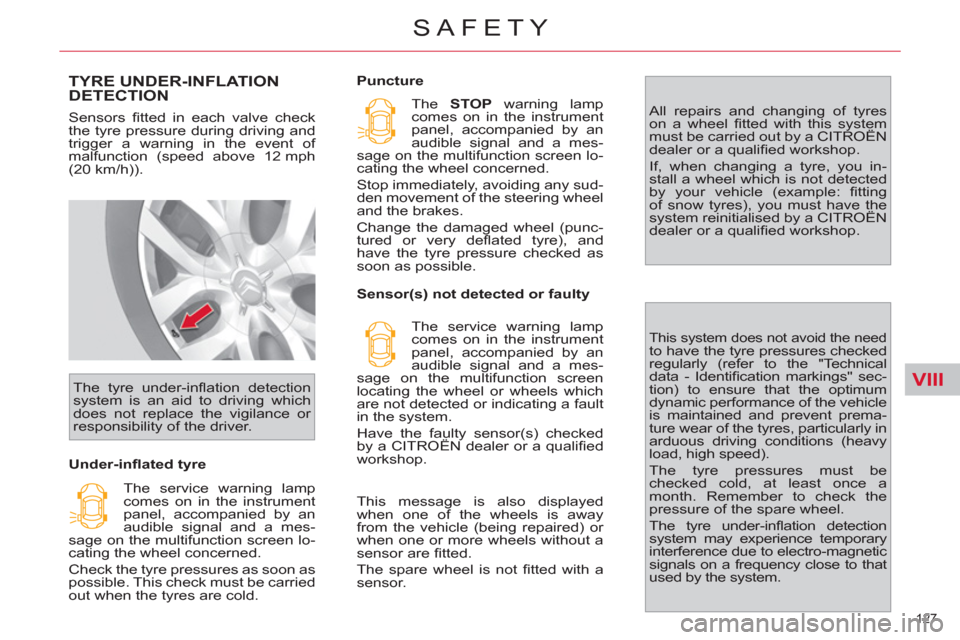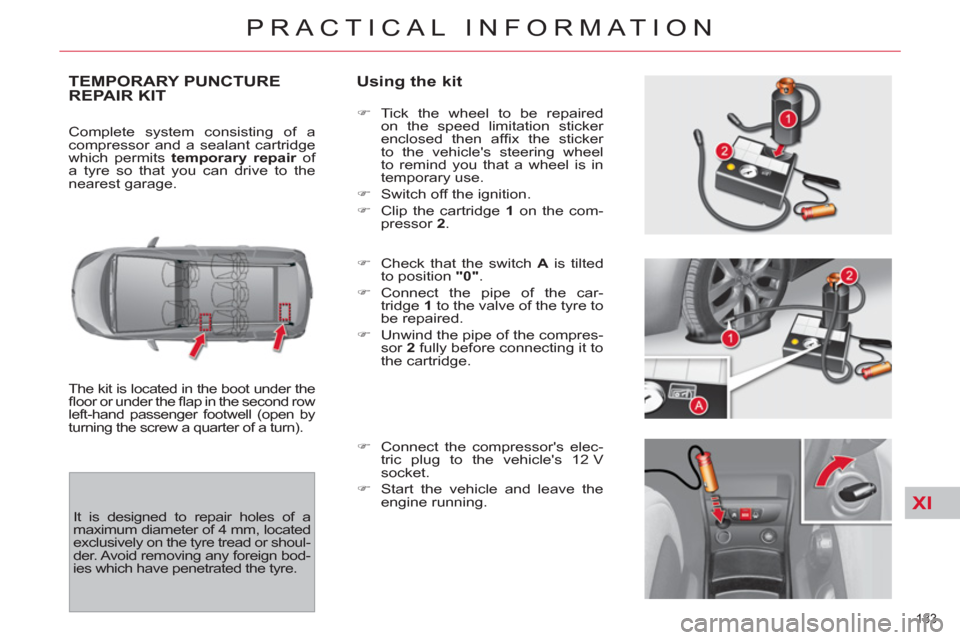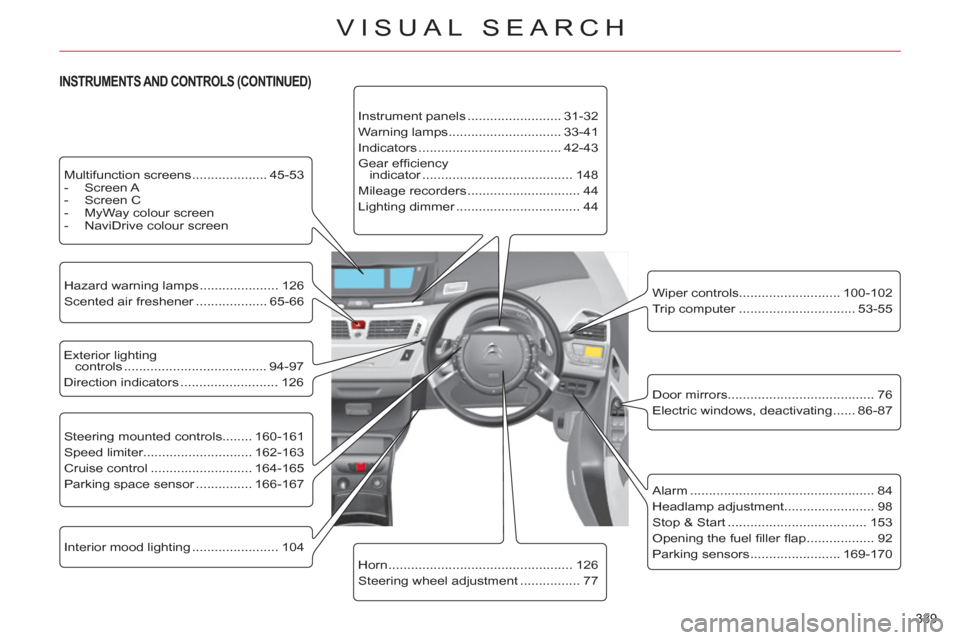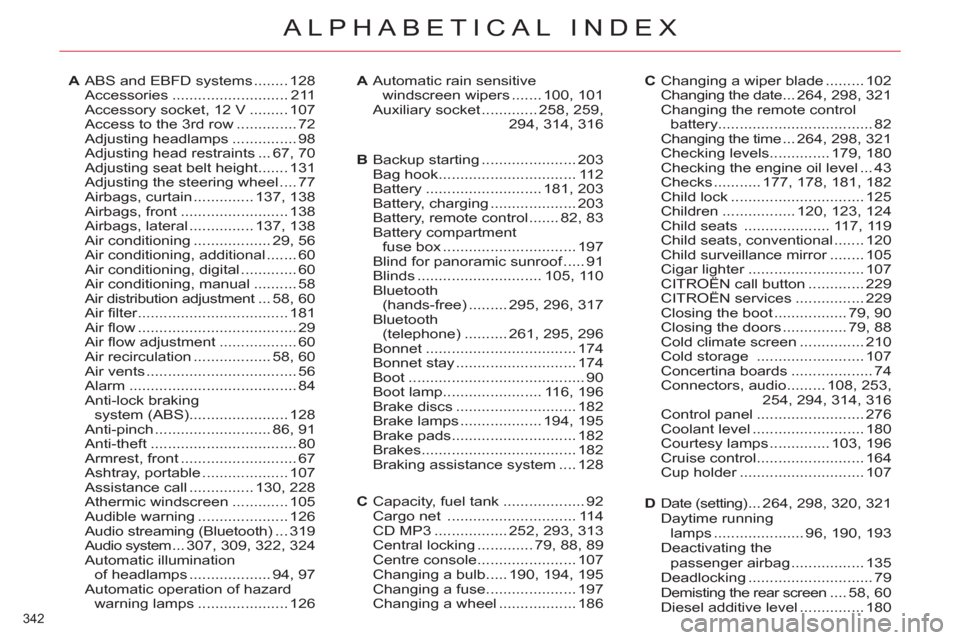steering wheel Citroen C4 PICASSO RHD 2012 1.G User Guide
[x] Cancel search | Manufacturer: CITROEN, Model Year: 2012, Model line: C4 PICASSO RHD, Model: Citroen C4 PICASSO RHD 2012 1.GPages: 352, PDF Size: 9.91 MB
Page 129 of 352

VIII
127
SAFETY
TYRE UNDER-INFLATION DETECTION
Sensors fi tted in each valve check
the tyre pressure during driving and
trigger a warning in the event of
malfunction (speed above 12 mph
(20 km/h)).
Under-infl ated tyre The tyre under-infl ation detection
system is an aid to driving which
does not replace the vigilance or
responsibility of the driver.
Puncture
The service warning lamp
comes on in the instrument
panel, accompanied by an
audible signal and a mes-
sage on the multifunction screen lo-
cating the wheel concerned.
Check the tyre pressures as soon as
possible. This check must be carried
out when the tyres are cold. The STOP
warning lamp
comes on in the instrument
panel, accompanied by an
audible signal and a mes-
sage on the multifunction screen lo-
cating the wheel concerned.
Stop immediately, avoiding any sud-
den movement of the steering wheel
and the brakes.
Change the damaged wheel (punc-
tured or very defl ated tyre), and
have the tyre pressure checked as
soon as possible.
Sensor(s) not detected or faulty
The service warning lamp
comes on in the instrument
panel, accompanied by an
audible signal and a mes-
sage on the multifunction screen
locating the wheel or wheels which
are not detected or indicating a fault
in the system.
Have the faulty sensor(s) checked
by a CITROËN dealer or a qualifi ed
workshop. All repairs and changing of tyres
on a wheel fi tted with this system
must be carried out by a CITROËN
dealer or a qualifi ed workshop.
If, when changing a tyre, you in-
stall a wheel which is not detected
by your vehicle (example: fi tting
of snow tyres), you must have the
system reinitialised by a CITROËN
dealer or a qualifi ed workshop.
This system does not avoid the need to have the tyre pressures checked
regularly (refer to the "Technical
data - Identifi cation markings" sec-
tion) to ensure that the optimum
dynamic performance of the vehicle
is maintained and prevent prema-
ture wear of the tyres, particularly in
arduous driving conditions (heavy
load, high speed).
The tyre pressures must be
checked cold, at least once a
month. Remember to check the
pressure of the spare wheel.
The tyre under-infl ation detection
system may experience temporary
interference due to electro-magnetic
signals on a frequency close to that
used by the system.
This message is also displayed
when one of the wheels is away
from the vehicle (being repaired) or
when one or more wheels without a
sensor are fi tted.
The spare wheel is not fi tted with a
sensor.
Page 137 of 352

VIII
135
SAFETY
AIRBAGS
System designed to maximise the
safety of the occupants (with the
exception of the rear centre pas-
senger) in the event of violent col-
lisions. It supplements the action of
the force-limiting seat belts.
If a collision occurs, the electronic
detectors record and analyse the
front and side impacts sustained in
the impact detection zones:
- in the case of a serious impact,
the airbags are deployed instantly
and protect the occupants of the
vehicle (with the exception of the
rear centre passenger); imme-
diately after the impact, the air-
bags defl ate rapidly so that they
do not hinder visibility or the exit
of the occupants,
- in the case of a minor or rear im-
pact or in certain roll-over con-
ditions, the airbags will not be
deployed; the seat belt alone
is suffi cient to provide optimum
protection in these situations.
The airbags do not operate
when the ignition is switched
off.
This equipment will only operate
once. If a second impact occurs
(during the same or a subsequent ac-
cident), the airbag will not operate.
Impact detection zones
A.
Front impact zone.
B.
Side impact zone.
Deployment of the airbag(s) is ac-
companied by a slight emission of
harmless smoke and a noise, due to
the activation of the pyrotechnic car-
tridge incorporated in the system.
This smoke is not harmful, but sen-
sitive individuals may experience
slight irritation.
The noise of the detonation may
result in a slight loss of hearing for
a short time.
Front airbags
System which protects the head and
chest of the driver and front passen-
ger in the event of a front impact.
The driver's airbag is fi tted in the
centre of the steering wheel; the
front passenger's airbag is fi tted in
the dashboard above the glove box.
Deployment
The airbags are deployed simultane-
ously, unless the passenger's front
airbag is deactivated, in the event of
a serious front impact applied to all
or part of the front impact zone A
,
in the longitudinal centreline of the
vehicle on a horizontal plane and di-
rected from the front to the rear of
the vehicle.
The front airbag infl ates between the
front occupant of the vehicle and the
dashboard to cushion their forward
movement.
Page 140 of 352

VIII
138
SAFETY
For the airbags to be fully
effective, observe the following
safety rules:
Front airbags
Do not drive holding the steering
wheel by its spokes or resting your
hands on the centre part of the
wheel.
Passengers must not place their feet
on the dashboard.
If possible, do not smoke as deploy-
ment of the airbags can cause burns
or the risk of injury from a cigarette
or pipe.
Never remove or pierce the steering
wheel or hit it violently.
Lateral airbags
Use only approved covers on the seats,
compatible with the deployment the
lateral airbags. For information on the
range of seat covers suitable for your
vehicle, you can contact a CITROËN
dealer (see "Practical information - §
Accessories").
Do not fi x or attach anything to the
seat backs (clothing...). This could
cause injury to the chest or arms if
the lateral airbag is deployed.
Do not sit with the upper part of the
body any nearer to the door than
necessary.
Curtain airbags
Do not fi x or attach anything to the
roof. This could cause injury to the
head if the curtain airbag is de-
ployed.
If fi tted on your vehicle, do not re-
move the grab handles installed on
the roof, they play a part in securing
the curtain airbags.
Sit in a normal upright position.
Wear a correctly adjusted seat belt.
Do not leave anything between the
occupants and the airbags (a child,
pet, object...). This could hamper
the operation of the airbags or injure
the occupants.
After an accident or if the vehicle
has been stolen or broken into, have
the airbag systems checked.
All work on the airbag system must
be carried out by a CITROËN dealer
or a qualifi ed workshop.
Even if all of the precautions men-
tioned are observed, a risk of injury
or of minor burns to the head, chest
or arms when an airbag is deployed
cannot be ruled out. The bag infl ates
almost instantly (within a few mil-
liseconds) then defl ates within the
same time discharging the hot gas
via openings provided for this pur-
pose.
Page 162 of 352

IX
160
DRIVING
FIXED CENTRED CONTROLS STEERING WHEEL
Cruise control/speed limiter
and parking sensor controls
1.
Activation of the parking
sensors function.
2.
Selection of cruise control or
speed limiter.
3.
Activation/Deactivation of speed
limiter.
Deactivation/Reactivation of
cruise control.
4.
Increase speed/Activation of
cruise control.
5.
Decrease speed/Activation of
cruise control.
Audio system controls
A.
Volume decrease.
B.
Volume increase.
C.
Search of higher frequencies.
D.
Scrolling pre-set stations.
E.
Mute.
(see "Audio and Telematics" section)
Page 164 of 352

IX
162
DRIVING
SPEED LIMITER
System which prevents the vehi-
cle from exceeding the speed pro-
grammed by the driver.
Once the limit speed has been
reached, the accelerator pedal no
longer has any effect.
The speed limiter is switched on
manually: a speed of at least 20 mph
(approximately 30 km/h) must be
programmed.
The speed limiter controls are located
on the left-hand side of the steering
wheel. The programmed information is
grouped together in zone A
of the
instrument panel screen.
Steering mounted controls
Displays in the instrument
panel
Programming
Rotate the control 1
to the "LIM"
po-
sition.
With the engine running, you can
adjust the memorised maximum
speed , by means of short or long
presses on:
�)
button 4
to increase the memo-
rised maximum speed,
�)
button 2
to decrease the memo-
rised maximum speed.
Successive presses will modify the
maximum speed in steps of 1 mph
(1 km/h) and a sustained press in
steps of 3 mph (5 km/h).
Activation
When the desired maximum speed
is displayed, press button 3
so that
the limitation is activated.
On selection of the
function, the previous
memorised speed and
the information "OFF"
are displayed in the in-
strument panel. The information "OFF"
then disappears from
the instrument panel
screen.
While the function is active, pressing
the accelerator pedal will not enable
the programmed speed to be ex-
ceeded, except if you press the pedal
hard down to beyond the end-of-travel
switch.
The speed of your vehicle may vary
slightly in relation to that memorised.
The speed limiter cannot, in any circum-
stances, take the place of the obser-
vance of speed limits or of the vigilance
and responsibility of the driver.
Page 166 of 352

IX
164
DRIVING
CRUISE CONTROL
System which automatically main-
tains the vehicle speed programmed
by the driver, without any action on
the accelerator pedal.
The cruise control is switched on
manually: the vehicle speed must
be at least 25 mph (approximately
40 km/h) and you must engage:
- fourth gear on a manual gearbox,
- second gear, in manual mode,
on an electronic or automatic
gearbox,
- position A
on an electronic gear-
box or D
on an automatic gearbox.
Steering mounted controls
The cruise control switches are lo-
cated on the left-hand side of the
steering wheel. The programmed information is
grouped together in zone A
of the
instrument panel screen.
Displays in the instrument
panel
Activation
You can then release the accelerator
pedal. The vehicle will automatically
keep to the speed chosen.
The speed of your vehicle may vary
slightly in relation to that memo-
rised.
You can adjust the memorised speed
in the instrument panel screen by
pressing:
�)
button 4
to increase the speed,
�)
button 2
to decrease the speed.
Successive presses modify the
cruise speed in steps of 1 mph
(1 km/h) and a sustained press in
steps of 3 mph (5 km/h).
Deactivation
�)
Either by pressing the brake or
the clutch pedal.
�)
Or by pressing button 3
.
�)
Or if either the ESP or the ASR
system is active.
The cruise control is not active if the
gear lever is in neutral. On selection of the
function via control 1,
no cruise speed has
yet been memorised.
Programming
Rotate the control 1
to the "REG"
position.
Once the desired speed has been
reached using the accelerator, press
button 2
or 4
. The cruise speed is
then memorised. It is displayed in
zone A
of the instrument panel. These actions cause
the information "OFF"
to appear in the instru-
ment panel screen.
These actions do not
cancel the cruise speed
which remains displayed in the instrument panel.
The cruise control cannot, in any circum-
stances, take the place of the obser-
vance of speed limits or of the vigilance
and responsibility of the driver.
Page 185 of 352

XI
183
PRACTICAL INFORMATION
TEMPORARY PUNCTURE
REPAIR KIT
Using the kit
The kit is located in the boot under the
fl oor or under the fl ap in the second row
left-hand passenger footwell (open by
turning the screw a quarter of a turn).
�)
Tick the wheel to be repaired
on the speed limitation sticker
enclosed then affi x the sticker
to the vehicle's steering wheel
to remind you that a wheel is in
temporary use.
�)
Switch off the ignition.
�)
Clip the cartridge 1
on the com-
pressor 2
.
�)
Check that the switch A
is tilted
to position "0"
.
�)
Connect the pipe of the car-
tridge 1
to the valve of the tyre to
be repaired.
�)
Unwind the pipe of the compres-
sor 2
fully before connecting it to
the cartridge.
�)
Connect the compressor's elec-
tric plug to the vehicle's 12 V
socket.
�)
Start the vehicle and leave the
engine running. Complete system consisting of a
compressor and a sealant cartridge
which permits temporary repair
of
a tyre so that you can drive to the
nearest garage.
It is designed to repair holes of a
maximum diameter of 4 mm, located
exclusively on the tyre tread or shoul-
der. Avoid removing any foreign bod-
ies which have penetrated the tyre.
Page 210 of 352

XI
208
PRACTICAL INFORMATION
General recommendations
Observe the legislation in force in your country.
Ensure that the weight of the towing vehicle is higher than that of the towed vehicle.
The driver must stay at the wheel of the towed vehicle.
Driving on motorways and fast roads is prohibited when towing.
When towing a vehicle with all four wheels on the ground, always use an approved towing bar; rope and straps are
prohibited.
When towing a vehicle with the engine off, there is no longer any power assistance for braking or steering.
In the following cases, you must always call on a professional recovery service:
- vehicle broken down on a motorway or fast road,
- when it is not possible to put the gearbox into neutral, unlock the steering, or release the parking brake,
- towing with only two wheels on the ground,
- where there is no approved towing bar available...
Page 341 of 352

339
VISUAL SEARCH
Exterior lighting
controls ...................................... 94-97
Direction indicators .......................... 126
Steering mounted controls........ 160-161
Speed limiter............................. 162-163
Cruise control ........................... 164-165
Parking space sensor ............... 166-167
Alarm ................................................. 84
Headlamp adjustment........................ 98
Stop & Start ..................................... 153
Opening the fuel fi ller fl ap .................. 92
Parking sensors ........................ 169-170
Instrument panels ......................... 31-32
Warning lamps .............................. 33-41
Indicators ...................................... 42-43
Gear effi ciency
indicator ........................................ 148
Mileage recorders .............................. 44
Lighting dimmer ................................. 44
Door mirrors ....................................... 76
Electric windows, deactivating ...... 86-87
Horn ................................................. 126
Steering wheel adjustment ................ 77
Hazard warning lamps ..................... 126
Scented air freshener ................... 65-66
Wiper controls........................... 100-102
Trip computer ............................... 53-55
Interior mood lighting ....................... 104
Multifunction screens .................... 45-53
- Screen A
- Screen C
- MyWay colour screen
- NaviDrive colour screen
INSTRUMENTS AND CONTROLS (CONTINUED)
Page 344 of 352

342
ALPHABETICAL INDEX
ABS and EBFD systems ........ 128Accessories...........................211Accessory socket, 12 V .........107Access to the 3rd row..............72Adjusting headlamps...............98Adjusting head restraints...67,70Adjusting seat belt height.......131Adjusting the steering wheel ....77Airbags, curtain..............137,138Airbags, front.........................138Airbags, lateral ...............137,138Air conditioning..................29,56Air conditioning, additional.......60Air conditioning, digital .............60Air conditioning, manual..........58Air distribution adjustment...t58,60Air filter...................................r181Air flow .....................................29Air flow adjustment ..................60Air recirculation..................58,60Air vents...................................56Alarm.......................................84Anti-lock brakingsystem (ABS).......................128Anti-pinch...........................86,91Anti-theft ..................................80Armrest, front...........................67Ashtray, portable....................107Assistance call ...............130,228Athermic windscreen.............105Audible warning.....................126Audio streaming (Bluetooth)...319Audio system ...307,309, 322,324Automatic illumination
of headlamps...................94,97Automatic operation of hazard
warning lamps .....................126
Automatic rain sensitivewindscreen wipers .......100, 101Auxiliary socket.............258,259,294,314, 316
Changing a wiper blade ......... 102Changing the date ...264, 298,321Changing the remote controlbattery....................................82Changing the time ...264, 298,321Checking levels.............. 179,180Checking the engine oil level ...43Checks ...........177,178, 181,182Child lock............................... 125Children .................120, 123,124Child seats .................... 117,119Child seats, conventional ....... 120Child surveillance mirror........r105Cigar lighter...........................r107CITROËN call button ............. 229CITROËN services ................ 229Closing the boot .................79,90Closing the doors ...............79,88Cold climate screen ............... 210Cold storage ......................... 107Concertina boards ...................74Connectors, audio......... 108, 253,
254,294, 314,316Control panel ......................... 276Coolant level .......................... 180Courtesy lamps .............. 103,196Cruise control......................... 164Cup holder.............................r107
AAC
BBackup starting......................203Bag hook................................112Battery...........................181, 203Battery, charging....................203Battery, remote control.......82,83Battery compartment
fuse box...............................197Blind for panoramic sunroof.....f91Blinds.............................105, 110Bluetooth(hands-free).........295,296, 317Bluetooth(telephone)..........261,295, 296Bonnet...................................174Bonnet stay............................174Boot.........................................90Boot lamp.......................116, 196Brake discs............................182Brake lamps...................194, 195Brake pads.............................182Brakes....................................182Braking assistance system....128
Date (setting) ...264,298, 320,321Daytime runninglamps.....................96, 190,193Deactivating the passenger airbag.................135Deadlocking.............................79Demisting the rear screen....58,60Diesel additive level...............180
Capacity, fuel tank...................92Cargo net..............................114CD MP3.................252,293, 313Central locking .............79, 88,89Centre console.......................107Changing a bulb.....190,194, 195Changing a fuse.....................197Changing a wheel..................186
CD